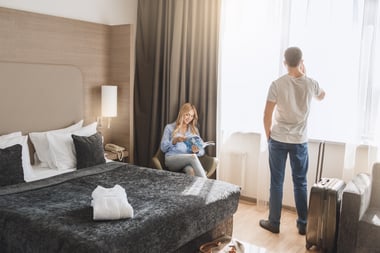In an article which describes OTA advertising tactics as “bullish”, AdAge lays out the problem with OTA marketing budgets. Without properties to care for, they can “shovel” revenue into advertising, research, and similar activities. Trivago, for example, poured 82.7% of their worldwide revenue into advertising.
Hotels obviously cannot and should not do this. So what can they do to promote their brand directly to customers? Large chains have, of course, been creating large ad campaigns of their own, and are revamping loyalty programs to focus on savings and rewards. Independents must be even more innovative.
A new study from Kalibri Labs indicates that hotels in the US are paying more on average to acquire customers. Half of these costs go to third parties, the other half is paid for direct expenses. With the variety of platforms and the now-inevitable ‘pay for play’ strategies on search and social, the industry is just that bit less efficient, Mark Lomanno of Kalibri Labs says.
A more optimistic piece, also written by Mark Lomanno, analyzes hotels’ strengths and weaknesses today, and advocates the ‘rise of direct bookings’ and the ways hotels can encourage guests to book through the lowest-cost channels – direct ones.
OTAs Go on Summer Spending Spree
They are battling each other and hotel brands like Marriott and Hilton for pieces of the more than $67.2 billion online U.S. hotel and lodging market – and they are winning: OTAs now control more than half of online hotel bookings.
Hotels are fighting back, but their adversaries have a unique advantage: They can plow huge amounts of their revenue back into ad spending because they don’t have the burden of caring for properties.
Hoteliers spending more to get customers in the door
Hoteliers in the United States are paying, on average, 16 percent to 18 percent to acquire customers, with many paying as much as 25 percent to 35 percent, according to two experts from Kalibri Labs. About half is paid to third parties and half is paid for direct expenses.
The company collected data for more than 25,000 hotels from big and small chains as well as independents from more than 100 brands with 3 million rooms in the U.S, tracking more than 5 billion transactions.
The Rise of Indirect Bookings
For hotels, indirect bookings typically come with a higher cost of acquisition compared to direct channel bookings. Therefore, many brands are now putting a larger focus on driving guests to book directly.
For individual hoteliers, an awareness of the profitability of your property’s distribution channels is vital. Some of the consumer shift to digital channels is unavoidable, but hoteliers have the ability to manage within that shift and work to guide as many guests as possible to the lowest-cost channels.
Expedia Reports Higher ADR and Growth for Independent Hotels
For Q1 2017, Expedia data shows independent hotels continue to excel on ADR growth versus branded properties, and in addition, travelers spent more per night at independent hotels than at branded properties during the time.
Last year was a pivotal one for independent hotels, per STR, an American company that tracks supply and demand data for multiple market sectors, which revealed that these ‘un-branded’ properties had greater overall average daily rate (ADR) and revenue per available room (RevPAR) than their branded hotel brethren.



